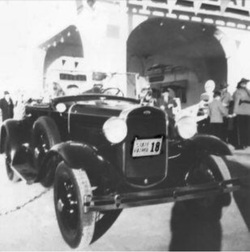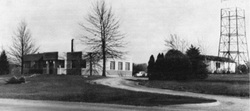The History of Troop B.

By Merlyn Amidei - Information gathered from the Highway Patrol and the Macon Chronicle-Herald
After Theodore Gary was chairman of the Missouri State Highway Commission and had secured at least two major hard roads for all 114 counties of Missouri, the work was not yet complete. There had to be someway to promote safety and goodwill. Thus, by the 56th General Assembly of the legislature in 1931, the Missouri State Highway Patrol was created. Then Governor Henry S. Caulfield named Lewis Ellis as the first Superintendent. He and others visited several other Eastern states reviewing patrol systems so that Missouri might build on a sound foundation based on the experiences of others. Out of those findings the non-partisan Missouri Highway Patrol was established with 55 men being selected from thousands of applicants. Among the 55 new officers, ten were natives of the Northeast Missouri area. The St. Louis Police Academy was the site for the training for the new recruits and they were ready for duty in November 1931. Gary fought for and secured Troop B to be stationed in Macon. Other troops were placed at Kansas City, Kirkwood, Springfield and Sikeston with the headquarters and troop in Jefferson City. At the beginning, 22 counties were included in the Troop B territory, practically all of the Northeast corner of the state. Also nine of the original 55 troopers were assigned here. The troop commander was Captain Schuyler S. French and First Sergeant Benjamin O. Booth were both stationed here in Macon with others being spread out around the area in Chillicothe, Hannibal, Prairie Hill, Unionville, Trenton, Kirksville and Lewistown. An interesting tidbit is that all 55 of the new Patrolmen wore boots that were manufactured by the Central Shoe Company of Moberly.
Troopers used Harley Davidson motorcycles, 1931 Chevrolet
sedans or 1931 Ford Model A Roadsters such as the one shown here. They patrolled designated routes primarily along major highways and worked a minimum of 12 hours a day. Their salary was $125 per month and they got two days a month off. Of course there were no radio communications back then so they relied on the telephone. They made regular stops along their route - at restaurants, service stations, sheriffs' offices, etc - where messages were taken for them.
Their first headquarters consisted of two rooms in the State Highway
Department offices on the second floor of the Masonic Building at the corner of
Vine & Rollins. Next they moved to small wooden building behind the old District 2 Highway Department office on US 63 in 1935. After the new Highway Department building was completed in early 1937 the Highway Patrol's headquarters was then relocated to the
basement of that building.
After Theodore Gary was chairman of the Missouri State Highway Commission and had secured at least two major hard roads for all 114 counties of Missouri, the work was not yet complete. There had to be someway to promote safety and goodwill. Thus, by the 56th General Assembly of the legislature in 1931, the Missouri State Highway Patrol was created. Then Governor Henry S. Caulfield named Lewis Ellis as the first Superintendent. He and others visited several other Eastern states reviewing patrol systems so that Missouri might build on a sound foundation based on the experiences of others. Out of those findings the non-partisan Missouri Highway Patrol was established with 55 men being selected from thousands of applicants. Among the 55 new officers, ten were natives of the Northeast Missouri area. The St. Louis Police Academy was the site for the training for the new recruits and they were ready for duty in November 1931. Gary fought for and secured Troop B to be stationed in Macon. Other troops were placed at Kansas City, Kirkwood, Springfield and Sikeston with the headquarters and troop in Jefferson City. At the beginning, 22 counties were included in the Troop B territory, practically all of the Northeast corner of the state. Also nine of the original 55 troopers were assigned here. The troop commander was Captain Schuyler S. French and First Sergeant Benjamin O. Booth were both stationed here in Macon with others being spread out around the area in Chillicothe, Hannibal, Prairie Hill, Unionville, Trenton, Kirksville and Lewistown. An interesting tidbit is that all 55 of the new Patrolmen wore boots that were manufactured by the Central Shoe Company of Moberly.
Troopers used Harley Davidson motorcycles, 1931 Chevrolet
sedans or 1931 Ford Model A Roadsters such as the one shown here. They patrolled designated routes primarily along major highways and worked a minimum of 12 hours a day. Their salary was $125 per month and they got two days a month off. Of course there were no radio communications back then so they relied on the telephone. They made regular stops along their route - at restaurants, service stations, sheriffs' offices, etc - where messages were taken for them.
Their first headquarters consisted of two rooms in the State Highway
Department offices on the second floor of the Masonic Building at the corner of
Vine & Rollins. Next they moved to small wooden building behind the old District 2 Highway Department office on US 63 in 1935. After the new Highway Department building was completed in early 1937 the Highway Patrol's headquarters was then relocated to the
basement of that building.

Later in 1937 grounds were purchased specifically for Troop B, so in March
of 1938 they became the first troop to operate from a building designed
especially for them. Radio transmitter station KHPB was established at their new
headquarters, which greatly modernized and expedited their communications.
With so much growth taking place after World War II, the
troops were reorganized, so in 1946 Troop B was reduced to the 16 counties it contains today.
By 1960 the patrol had once again outgrown its facilities, so plans were made for another building to be constructed just west of the previous one. Captain Samuel S. Smith was troop commander at the time and later served as the Superintendent of the Patrol from 1973- 1977.
The patrol has continued to grow and in 1987 a new 4,000 foot addition was constructed, adding not only office space but also a four-position indoor firing range. The patrol has continued to grow in personnel and now has 68 uniformed officers plus 42 full-time civilian employees.
Wouldn't those original troopers be in awe of the technological instruments used by law enforcement today? Radar, breathalyzers, polygraphs, fingerprints, radios and computers ... just to name a few of the advancements that have made impressive improvements for the officers of today. However, those patrol pioneers in Troop B - with their wit and raw courage - carved out a well-deserved reputation for efficiency, effectiveness and fairness with the public that still remains to this day. Whenever we see one of our uniformed officers we should all thank them for the sacrifices they make and the
difficult job they valiantly perform on a daily basis.
of 1938 they became the first troop to operate from a building designed
especially for them. Radio transmitter station KHPB was established at their new
headquarters, which greatly modernized and expedited their communications.
With so much growth taking place after World War II, the
troops were reorganized, so in 1946 Troop B was reduced to the 16 counties it contains today.
By 1960 the patrol had once again outgrown its facilities, so plans were made for another building to be constructed just west of the previous one. Captain Samuel S. Smith was troop commander at the time and later served as the Superintendent of the Patrol from 1973- 1977.
The patrol has continued to grow and in 1987 a new 4,000 foot addition was constructed, adding not only office space but also a four-position indoor firing range. The patrol has continued to grow in personnel and now has 68 uniformed officers plus 42 full-time civilian employees.
Wouldn't those original troopers be in awe of the technological instruments used by law enforcement today? Radar, breathalyzers, polygraphs, fingerprints, radios and computers ... just to name a few of the advancements that have made impressive improvements for the officers of today. However, those patrol pioneers in Troop B - with their wit and raw courage - carved out a well-deserved reputation for efficiency, effectiveness and fairness with the public that still remains to this day. Whenever we see one of our uniformed officers we should all thank them for the sacrifices they make and the
difficult job they valiantly perform on a daily basis.